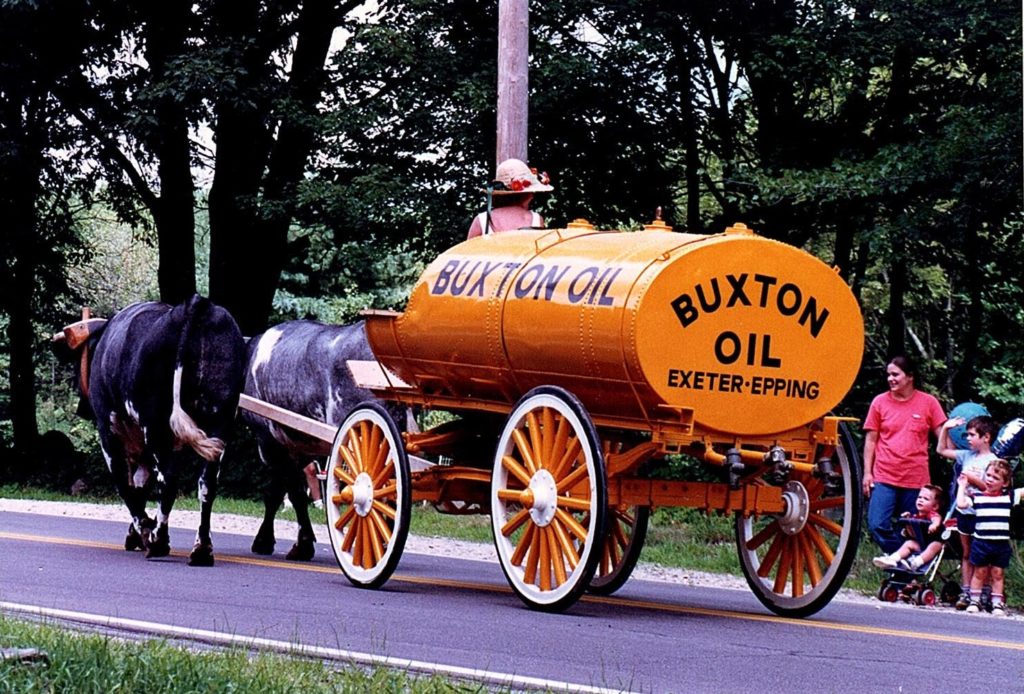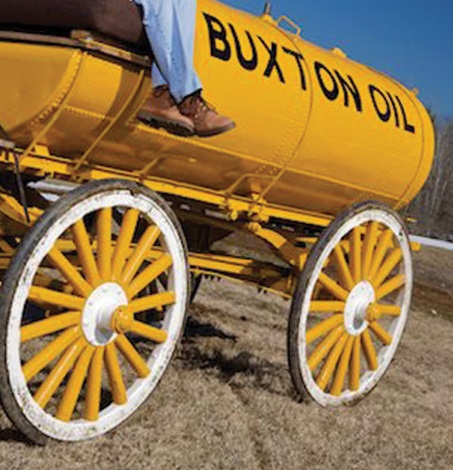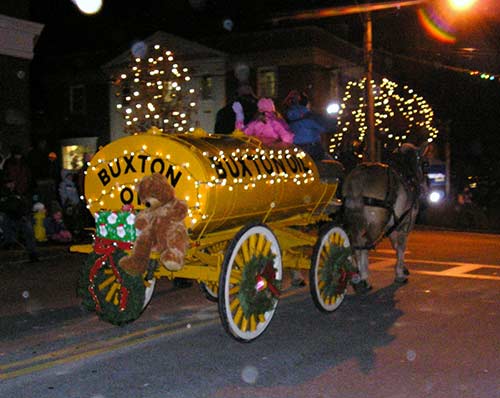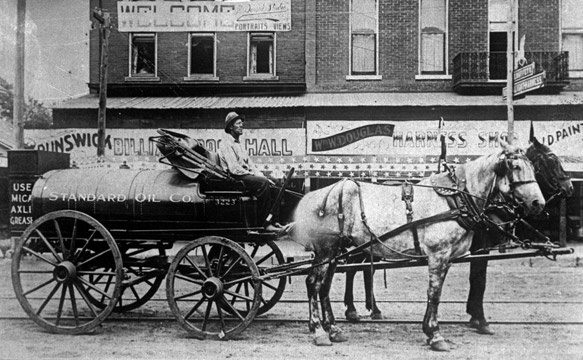A potential exhibit about early 20th century petroleum infrastructure and transportation.
An Epping, New Hampshire, family business oil wagon is available to educate museum visitors about early petroleum transportation technologies.
Buxton Oil Company was started in 1960 by Kenneth B. Buxton. When he passed away in 2011, his daughter Donna took the reigns and grew the business into one of the most recognized energy companies in New England. She also kept a horse-drawn oil wagon he had acquired.
Donna Buxton, who sold Buxton Oil in 2018, currently owns and operates Buxton Water Company, wants to find a home for her family’s “beautifully restored antique oil delivery wagon and a massive book that includes history awards and accolades.”

Seeking a museum home or permanent display for her former Epping, N.H., company’s oil wagon, she asked the American Oil & Historical Society’s help in contacting museums (see other examples at AOGHS Oil & Gas Families).
Except when rolled out for fuel and energy shows, the Buxton Oil wagon has been carefully stored in a climate controlled garage in Exeter.
Contact the Owner
“Beside being in local parades, the wagon has been displayed at the New England Fuel institute in Boston and recently at the National Energy Expo in Providence, Rhode Island,” Baxter explains. “This piece is a show stopper and certainly an important part of history and how the transportation and the industry has changed,”

The Buxton Oil wagon would be a great addition to any energy or transportation collection, and “it certainly would be wonderful for our family if a museum would display it.”
If an appropriate museum or historical site can be found, she would be pleased to donate her family’s oil wagon and assist with its transportation and display. To learn more, email bawells@aoghs.org or call Donna Baxter directly at (603) 365-7116.

———————
Oil and Kerosene Wagons
Bulk horse drawn tankers were seen, “in both town and country, mainly from the late 1890s to the early 1920s,” according to historian D.J. Smith in his 1977 book, Discovering Horse-Drawn Commercial Vehicles. “A number were used, during the 1900s, by large oil and petrol companies. They could be adapted, however, for any type of bulk liquid, from water to paraffin.”
Consumer demand for kerosene lamp fuel led to many commercial, horse-drawn vehicles. Many designs included a riveted tank with three compartments. The tank’s supporting wagon measured about 11 feet long and 5 feet wide. A typical wagon was pulled by two horses with the driver sitting on a padded seat, often built into the tank.

A typical Standard Oil Company of New Jersey kerosene delivery wagon, circa 1900. Photo courtesy Michigan State University.
Usually, oil tanks included three separate compartments (filled from top) designed to carry kerosene, heating oil, and other fluids that could flow out the rear of the tank via separate pipes and valves. Some early tankers rolled on iron (later steel) frames with 40-inch wheels on the front and 48-inch wheels on the rear and equipped with a manual lever hand brake.

A late 1880s Continental Oil Company oil tank wagon has welcomed visitors to the Conoco Museum in Ponca City, Oklahoma, since 2007. Phillips Petroleum Company, once headquartered 70 miles east in Bartlesville, merged with Conoco in 2002. Photo by Bruce Wells.
In May 2007, ConocoPhillips opened two oil museums on the same day as part of the 2007 Oklahoma statehood centennial celebrations. Exhibits at the Conoco Museum In Ponca City educate visitors about that company’s start in 1875 in Utah as a small distributor of coal, grease, and kerosene.
In addition to making deliveries with horse-drawn tank wagons, the Ogden-based Continental Oil and Transportation Company purchased railroad oil tank cars – the first to be used west of the Missouri River.

Docent Shirley Patterson and a Phillips 66 wagon welcomed visitors to the Phillips Petroleum Company Museum in Bartlesville, Oklahoma, in 2012. Brothers Frank and L.E. Phillips founded their oil exploration company in 1903. Photo by Bruce Wells.
Museum docent Shirley Patterson in 2012 welcomed visitors to the Phillips Petroleum Company Museum, offering rare insights about the company she joined in 1952 as a secretary for top executives. During her career, Patterson worked for every Phillips Petroleum president except for the first, founder Frank Phillips.
Learn more in ConocoPhillips Petroleum Museums.
_______________________
Recommended Reading: Discovering Horse-Drawn Commercial Vehicles (1977). Your Amazon purchase benefits the American Oil & Gas Historical Society. As an Amazon Associate, AOGHS earns a commission from qualifying purchases.
_______________________
The American Oil & Gas Historical Society preserves U.S. petroleum history. Become an AOGHS supporting member and help maintain this energy education website and expand historical research. For more information, contact bawells@aoghs.org. Copyright © 2021 Bruce A. Wells.

